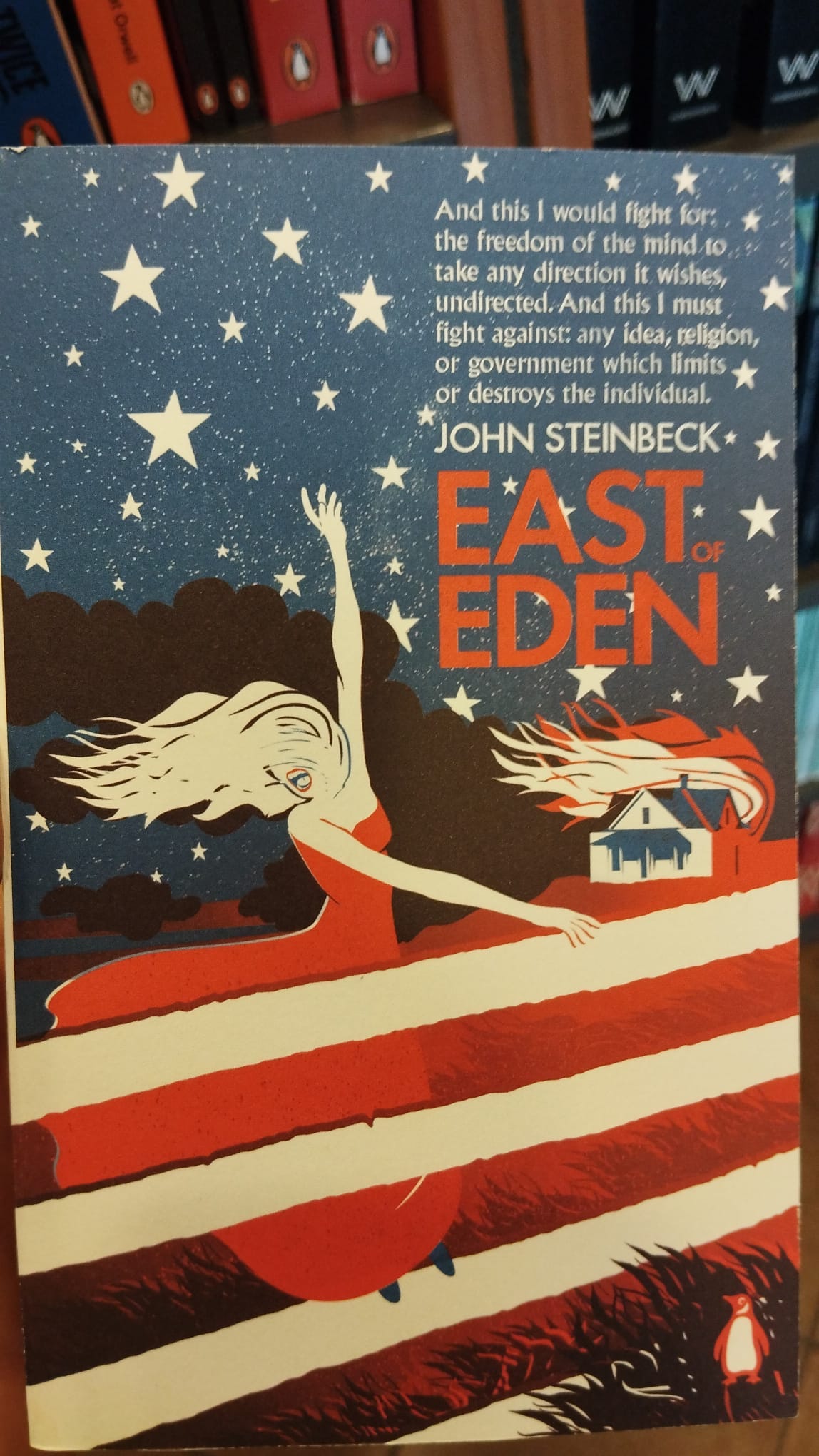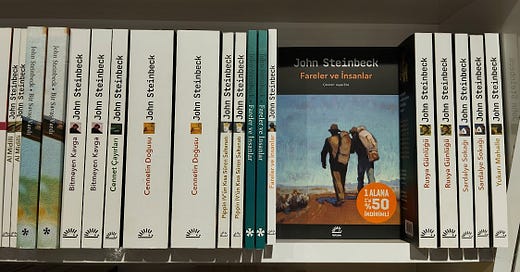Turkey's Favorite American Writer
Is also my favorite writer: John Steinbeck. What's the connection? I have some thoughts.
I’ll never forget my first trip to a Turkish bookstore.
It was my first weekend in Izmir, and at church someone had mentioned to me a shop where they had a selection of books in English. It was a store on Konak Pier, a fancy mall built into one of the docks at the old port. Their English selection was mostly classics and best-sellers.1
But as I looked around the store, I was amazed by the selection of books they had by John Steinbeck, my favorite American author.
And these books weren’t in English. They were in Turkish.
I was reminded of this again last weekend in Ankara, when I came across a bookstore in the Kizilay Metro Station.
It was a large bookstore, full of books and gifts. Unable to find an English selection, I found the shelf of Steinbeck books.
Have a look:
The cover that you see is a pretty easy one to figure out: Fareler means “mice” in Turkish. “Mice and People” is the best translation, as ‘men’ would be adamlar.
Here are the other titles with their translations:
Al Midilli — Red Pony
Bir Savaş Vardi — There Was a War
Bitmeyen Kavga — Neverending Fight (this must be In Dubious Battle)
Cennet Çayirlari — Heaven Pastures (The Pastures of Heaven — my personal favorite)
Cennetin Doğrusu — East of Heaven (Eden)
Pippin IV’un Kisa Suren Saltanati — The Short Reign of Pippin IV
Rusya Günlügü — Russian Journal
Sardalye Sokaği — Sardine Street (Cannery Row)
Yukari Mahalle — Upper District (Tortilla Flat)
You may notice that Steinbeck’s greatest work, The Grapes of Wrath, isn’t on the shelf. There was another half shelf below this one which also had his titles.
But I was amazed to see Pippin IV, a piece of political satire, and Once there Was a War, a novel he wrote as a propagandist during World War II. One wouldn’t find these in a bookstore in America. These are titles for big fans of the writer — titles that are widely available here in Turkey.
What could be the connection between Turkey and Steinbeck? I haven’t gotten a satisfactory answer — yet — from Turkish friends. I’d love to read your comments if you have a take.
These are my best guesses.

Connection to California
Steinbeck was a writer deeply connected to California. About half of the books are set among the farms, vallies and canneries near his home in Salinas.
Turkey is the California of Asia: the furthest west one can go on this grand continent before getting to the, well, “West.” The coastline is actually longer than California’s with Mediterranean and Aegean waters similar to Southern California, and the Black Sea coast similar to Northern California. Hilly, busy Istanbul is a cousin to San Francisco, while laid-back, sunny Izmir could be Los Angeles.
Inland, one finds fertile valleys and high mountains. Farm workers walking down a dusty road among orange trees. That happens here, just as it did in Steinbeck’s novels. Perhaps it’s easy to “see” Steinbeck’s landscapes because Turkey is so similar.
Early Turkish Literature
The Turkish Republic was founded 100 years ago. What followed was a social revolution that changed modes of dress and the very language itself. Turkish writers of the 1930s and 40s shared Steinbeck’s empathy for the working class. An affectionate term arose at that time, “Mehmetçik,” described the common men in the army and later extended to the workforce. As I have studied these writers, I have found clear connections to Steinbeck’s style:
Orhan Kemal (1914-1970) wrote a series of autobiographical novels beginning with My Father’s House that brought to life those on the margins, struggling to make their way in the new republic. My favorite of his novels, Cemile, is a love story set among 12-hour shifts in an Adana textile factory and features labor strife. Steinbeck wrote about labor in The Grapes of Wrath and In Dubious Battle but managed to avoid charges of being a Communist. Kemal was imprisoned for communist activities in the early 1940s (that is where his literary career began under the tutelage of fellow inmate, Nazim Hikmet, lion of Turkish poetry).
Yaşar Kemal (1923-2015) also wrote about the forgotten of society. His masterpiece, Mehmet, My Hawk! describes a young man who gets fed up with the abuse of his landlord (bey) and leaves his village to become a brigand. Mehmet and his band become the heroes, just as Danny leads a rag-tag group of heroic winos on Tortilla Flat or the hunted boy in Steinbeck’s short story, “Flight.”
Just this week I started a book by Latife Tekin (1957- ) called Berji Kristin: Tales from the Garbage Hills. In its cadence and its style, it echoes Tortilla Flat, as squatters race in to set up a community among the pollution and garbage heaps on the outskirts of a huge city. I will write further about this book once I finish. Still, I know enough to admire the social vision and the sense of place it shares with Steinbeck’s works.
The Izmir Book Fair is in full swing in Kultur Park this week. I visited today to check out the selection and just be around readers and writers. With this blog ready to publish, I was also on the lookout for my favorite American writer.
As you can see, I wasn’t disappointed.
Most Turkish book shops have a shelf or two of English-language books. Usually, I’m looking for Turkish writers to read in English, but I usually find classics and popular titles instead. “Istan-book” — as I call that wonderful city — has the nation’s best bookstores with an excellent selection of Turkish writers (and western writers writing about Turkey). My favorite is called “Book Shop” and it’s about a block from Sultanahmet Square. I can also recommend Homeros Kitabevi in the Kabataş district.





That’s very interesting, I didn’t know Steinbeck was popular in Turkey. A long-time resident of the San Francisco Bay Area, I spent 5 months in Turkey last year (mostly in Istanbul) and loved it. The views of the Bosphorus definitely reminded me of home. The Bodrum peninsula too. I didn’t visit many bookstores when I was there, but I did love the German Turkish bookstore/library on Istiklal street in Istanbul, with its wonderful cafe upstairs. A great place to sit and read. Thanks for this interesting article!